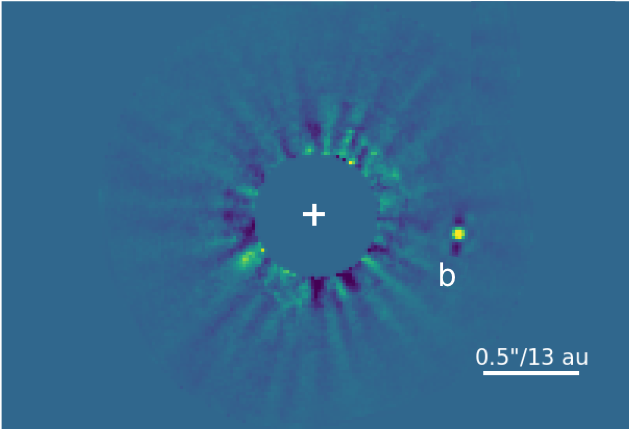Maunakea, Hawaii – Astronomers using two Maunakea Observatories – Subaru Telescope and W. M. Keck Observatory – have discovered a key benchmark brown dwarf orbiting a Sun-like star just 86 light-years from Earth that provides a key reference point for understanding the properties of the first directly-imaged exoplanets.
Subaru Telescope first detected and captured remarkably sharp pictures of the object. The team conducted follow-up observations at Subaru Telescope to take more direct images as well as at Keck Observatory to obtain infrared images and confirmed the object is an orbiting companion to the star HD 33632 Aa, and not an unrelated background star. Combined with complementary data from the Gaia space astrometry satellite, the researchers also found the brown dwarf has a mass of about 46 Jupiters.
Named HD 33632 Ab, the brown dwarf is one of only a few known objects of its kind orbiting a near-twin of the Sun at near-twin scales of our Solar System (Mercury to Pluto).
The study recently published in the November 30, 2020 issue of The Astrophysical Journal Letters.
Brown dwarfs are a class of objects that are smaller than stars but more massive than giant planets like Jupiter. They’re dubbed ‘failed stars’ because they’re not massive enough to ignite nuclear fusion in their cores and shine like true stars.
The team snapped pictures of the HD 33632 system using powerful adaptive optics (AO) technology at both Maunakea Observatories – Subaru Telescope’s state-of-the art exoplanet imaging system, SCExAO/CHARIS, and Keck Observatory’s advanced AO paired with its Near-Infrared Camera (NIRC2). These technologies remove the atmospheric blurring that distorts astronomical images, resulting in sharper images.
Subaru Telescope data showed the brown dwarf’s atmosphere may contain water and carbon monoxide.
“Thanks to SCExAO/CHARIS’s incredibly sharp images, we can not only see HD 33632 Ab but get ultra-precise measurements for its position and its spectrum, which gives important clues about its atmospheric properties and its dynamics,” said Thayne Currie, an affiliated researcher at Subaru Telescope and lead author of this study.
HD 33632 Ab provides critical new insight into the atmospheres of the planets in HR 8799 – the very first extrasolar system to have its picture taken – since its temperature is likely very similar, though it is older, has a higher mass, and has higher gravity.
“Keck Observatory’s NIRC2 thermal infrared data allowed us to better understand how HD 33632 Ab’s atmosphere compares to those of the first directly imaged exoplanets, HR 8799 bcde, which were discovered in part by Keck,” said Currie.
By studying HD 33632 Ab and the HR 8799 exoplanets, astronomers hope to learn more about how atmospheric conditions of planets and brown dwarfs are tied to the diversity of their age and compositions, such as mass, temperatures, and chemical properties.
Learn more: “SCExAO/CHARIS Nets its First Discovery” (Subaru Telescope Press Release, December 10, 2020).
ABOUT ADAPTIVE OPTICS
W. M. Keck Observatory is a distinguished leader in the field of adaptive optics (AO), a breakthrough technology that removes the distortions caused by the turbulence in the Earth’s atmosphere. Keck Observatory pioneered the astronomical use of both natural guide star (NGS) and laser guide star adaptive optics (LGS AO) and current systems now deliver images three to four times sharper than the Hubble Space Telescope at near-infrared wavelengths. AO has imaged the four massive planets orbiting the star HR8799, measured the mass of the giant black hole at the center of our Milky Way Galaxy, discovered new supernovae in distant galaxies, and identified the specific stars that were their progenitors. Support for this technology was generously provided by the Bob and Renee Parsons Foundation, Change Happens Foundation, Gordon and Betty Moore Foundation, Mt. Cuba Astronomical Foundation, NASA, NSF, and W. M. Keck Foundation.
ABOUT NIRC2
The Near-Infrared Camera, second generation (NIRC2) works in combination with the Keck II adaptive optics system to obtain very sharp images at near-infrared wavelengths, achieving spatial resolutions comparable to or better than those achieved by the Hubble Space Telescope at optical wavelengths. NIRC2 is probably best known for helping to provide definitive proof of a central massive black hole at the center of our galaxy. Astronomers also use NIRC2 to map surface features of solar system bodies, detect planets orbiting other stars, and study detailed morphology of distant galaxies.
ABOUT W. M. KECK OBSERVATORY
The W. M. Keck Observatory telescopes are among the most scientifically productive on Earth. The two 10-meter optical/infrared telescopes atop Maunakea on the Island of Hawaii feature a suite of advanced instruments including imagers, multi-object spectrographs, high-resolution spectrographs, integral-field spectrometers, and world-leading laser guide star adaptive optics systems. Some of the data presented herein were obtained at Keck Observatory, which is a private 501(c) 3 non-profit organization operated as a scientific partnership among the California Institute of Technology, the University of California, and the National Aeronautics and Space Administration. The Observatory was made possible by the generous financial support of the W. M. Keck Foundation. The authors wish to recognize and acknowledge the very significant cultural role and reverence that the summit of Maunakea has always had within the Native Hawaiian community. We are most fortunate to have the opportunity to conduct observations from this mountain.


